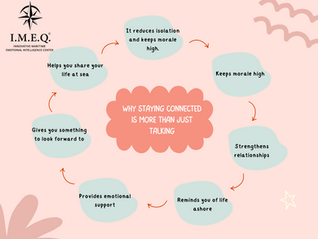Women in Shipping: Challenges, Solutions, and Thriving in a Male-Dominated Environment
- IMEQ CENTER

- Sep 17, 2023
- 4 min read

The maritime world, with its vast oceans and expansive horizons, has long been a domain primarily governed by men. However, the tide is changing. More women are stepping onto ships and into shipping offices, taking on roles that were, until recently, reserved predominantly for their male counterparts. Their presence heralds a fresh perspective and diversification. But, like any significant shift, it also brings unique challenges to the fore.

Within the confines of a ship, where boundaries are physically limited, the behavioral and societal boundaries can also blur, leading to amplified gender-related issues. Harassment is one of the significant challenges many women face in male-dominated industries, and it becomes even more pronounced on ships, where escape routes are limited, and authority dynamics can be rigid. The close quarters can mean that what starts as casual banter can quickly escalate to uncomfortable or even threatening situations.
Discrimination, on the other hand, might not always be as overt. It might manifest as condescension, assigning women less challenging tasks based on perceived incapabilities, or questioning their decisions more than those of their male counterparts. Such microaggressions, while seemingly subtle, can erode a woman's confidence over time.
Moreover, the sense of isolation onboard can be heightened for women. Far from the familiar support structures of family and friends, and perhaps being one of the few women or even the only woman on a ship, can amplify feelings of loneliness.
It's crucial for shipping companies not to gloss over these issues but to recognize the distinct challenges women face. An acknowledgment is the first step towards solution-seeking. A female seafarer should never feel her concerns are dismissed as inconsequential.
One effective strategy can be the establishment of women-centric peer support groups. Such groups can serve multiple purposes. They offer a platform for shared experiences, where women can find solace in the fact that they're not alone. These groups can also be think-tanks, where coping strategies are discussed, and solutions devised.
Counseling services, while beneficial for all seafarers, can be particularly invaluable for women if the counselors are trained to understand the nuances of gender in a maritime context. Such specialized counselors can provide insights, coping mechanisms, and therapeutic interventions tailored to the unique challenges female seafarers face.

The assertion that there is equipment women "cannot handle" can be problematic and oversimplifies the issue. Generally speaking, women are fully capable of operating and handling equipment on ships. However, the main concern arises from the fact that much of this equipment and its associated safety gear have been historically designed with the average male body in mind. This design bias can lead to ergonomic challenges, inefficiencies, and safety concerns. Here's a deeper exploration of these concerns:
1. Personal Protective Equipment (PPE):
Safety Boots: Often come in sizes that are too large for many women, leading to trip hazards and a lack of foot protection.
Gloves: Ill-fitting gloves can reduce dexterity, making it challenging to handle tools or perform intricate tasks.
Life Jackets & Safety Harnesses: Designed for male body proportions, they may not fit women correctly, compromising safety.
Hard Hats: Those that don't adjust adequately can impede vision or fall off easily.
2. Hand Tools:
Some heavy-duty tools might be disproportionately heavy or unwieldy for some women (and men) with smaller frames. This doesn't mean women can't use them, but it might be more challenging to use them efficiently or safely.
3. Control Panels and Machinery Interfaces:
These might be positioned at heights or angles optimized for average male heights, making them less ergonomic for individuals who are shorter.
4. Heavy Machinery:
Some machinery might require a certain level of physical strength for manual operation. While many women can and do meet these requirements, machinery designed without considering varying strength levels can be less efficient for operators with lesser physical strength.
5. Access Points and Passageways:
Some access points on ships, such as hatches or ladders, may be designed considering the average stride and reach of a male, which can be problematic for those with shorter stature.
6. Safety Protocols and Drills:
Activities like man-overboard drills might sometimes be based on the average male's weight and strength. These drills should account for variations to ensure everyone can participate and be rescued safely.

Then there's the often-tricky realm of communication. In a setting where clear communication can be the difference between smooth operations and catastrophic mishaps, ensuring everyone is on the same wavelength is crucial. Differences in communication styles, or pre-existing biases, might lead to misunderstandings or underestimation of a woman's capability. Workshops that bridge gender communication gaps, coupled with robust mentoring programs, can make a sea of difference.

Society, for centuries, has harbored stereotypes about 'appropriate' roles for women. These stereotypes aren't easily washed away, even by the most relentless of tides. The maritime industry isn't immune. Women find themselves constantly proving their worth, battling doubts seeded by societal expectations. Breaking these molds requires effort from both sides. Promoting success stories of women in shipping, running diversity workshops, and ensuring a genuine equal opportunity environment can chip away at these deep-seated beliefs.
In conclusion, the shipping industry stands at a crossroads. The entry of more women into this sector brings with it the promise of diversification and fresh perspectives. Addressing the challenges they face isn't just an act of equity; it's a step towards a more cohesive, innovative, and prosperous maritime future.
contact: pmh@imeq-center.com





































































































Comments